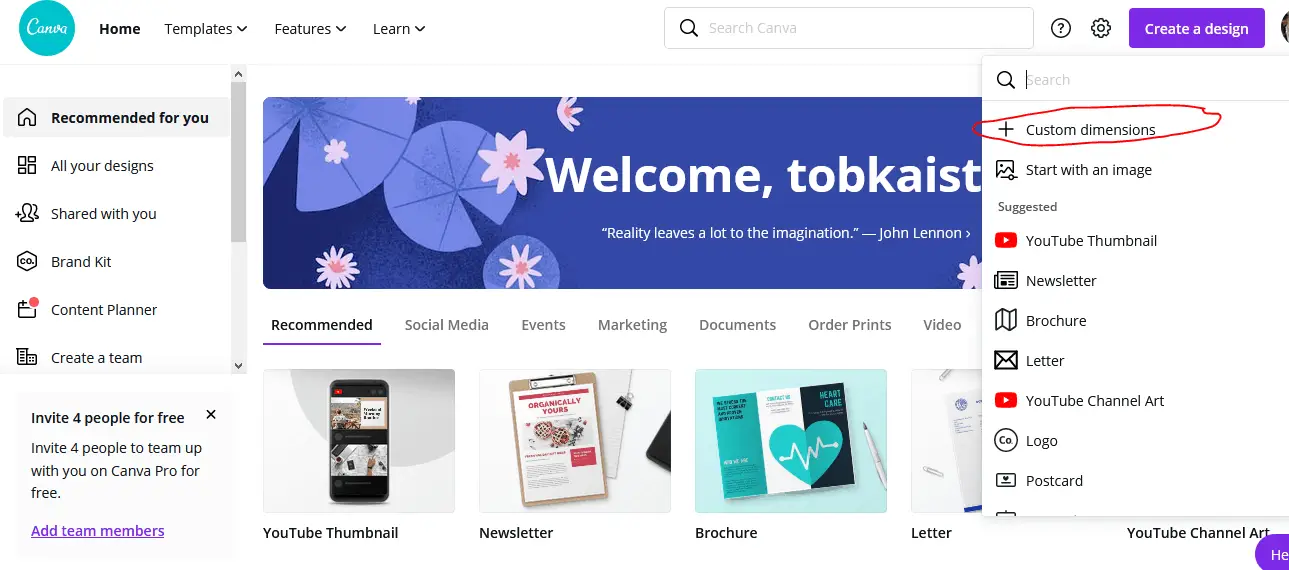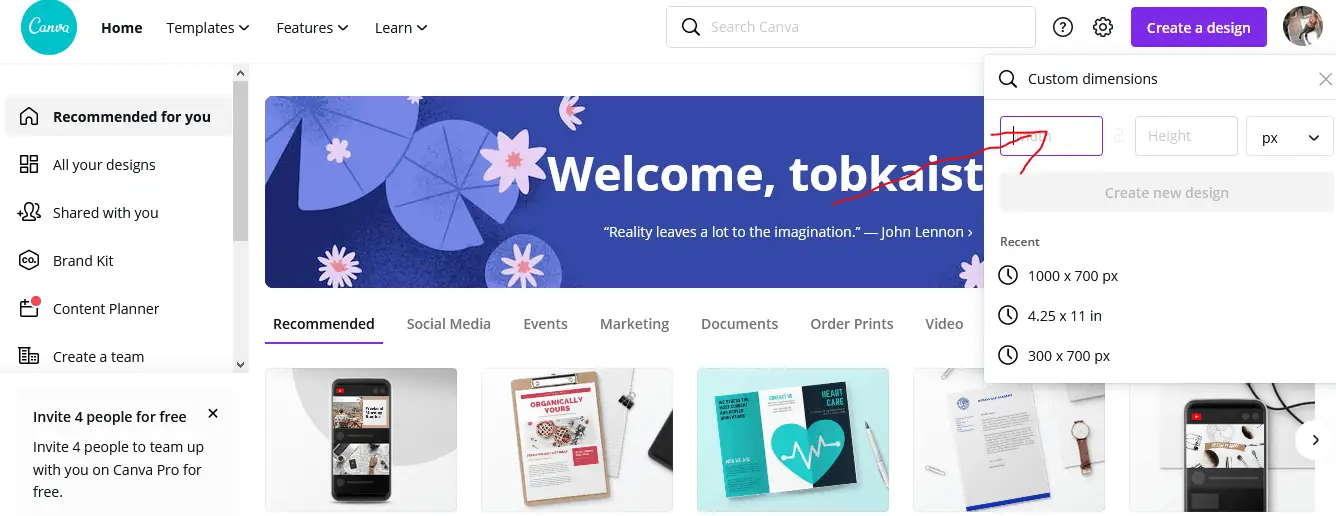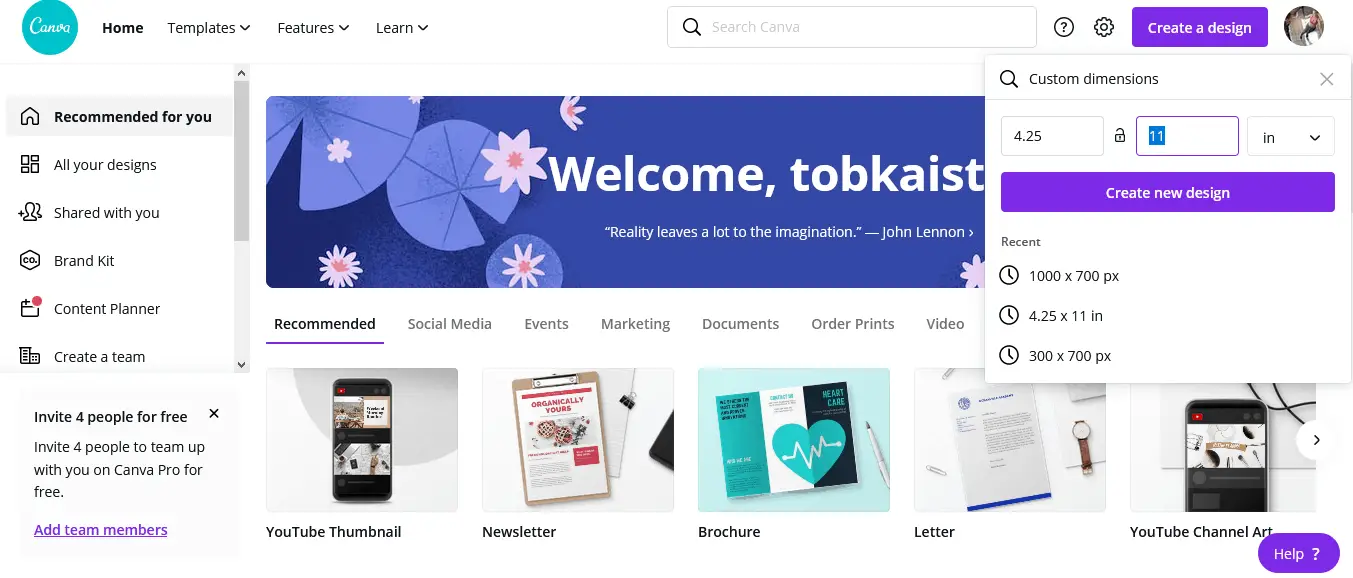Real estate professionals usually have to produce different marketing materials with time.
Sure, this could be outsourced. But costs can add up quickly if you use a professional graphic designer.
And going with professional design software can mean a steep learning curve and a significant time investment until you get to the point where you create real estate marketing materials in a decent amount of time.
This is time you could invest otherwise in generating real estate leads, for example.
Therefore, the web-based graphic design application Canva can be helpful.
It benefits graphic design “laymen” who want to create their real estate marketing material independently without the results looking crappy.
This article will teach you how to use Canva for real estate and why good graphics can boost your conversion rates.
What Is Canva?
I guess many professional graphic designers don’t like Canva too much.
This is understandable because this web-based design application is quite user-friendly, even for people who have never used professional design software such as Adobe Photoshop.
Even graphic design laymen can create nice-looking graphics in different formats with just a few clicks.
So, Canva is a free web-based graphic design application enabling you to create business cards, invitations, flyers, brochures, YouTube thumbnails, and more.
Depending on the use case or format you need, it provides you with many different design templates.
If you have individual photos, you can upload them and include them in your design or in a particular design template.
How many templates does Canva offer?
It has over 50,000 design templates that can be edited and customized using a drag-and-drop interface.
These are the different template categories Canva provides:
| Social Media | Personal | Business | Marketing | Education | Trending |
|---|---|---|---|---|---|
| Instagram Story | Invitation | Presentation | Poster | Lesson Plan | Gift Card |
| Instagram Post | Card | Website | Flyer | Worksheet | Christmas Card Certificate |
| Facebook Post | Resume | Logo | Infographic | Certificate | YouTube Intro |
| Facebook Cover | Postcard | Business Card | Brochure | Storyboard | Photo Books |
| YouTube Channel | Weekly Schedule | Invoice | Newsletter | Bookmark | Mugs |
| LinkedIn Banner | T-Shirt | Business Letterhead | Proposal | Class Schedule | Christmas Cards |
And these are the premade design templates provided for real estate:
- Real estate video templates
- Real estate postcard templates
- Real estate yard sign templates
- Real estate newsletter templates
- Real estate business card templates
- Real estate slideshow video templates
- Real estate social graphic templates
- Real estate flyer templates
- Real estate brochure templates
Canva’s Free, Pro and Enterprise Features with Pricing
| Free - $0 | Pro - $12.95/m | Enterprise - $30/m per person |
|---|---|---|
| 250,000+ free templates | All features of the Free Plan | All features of the Pro Plan |
| 100+ design types | 1 Brand Kit, and upload feature for your own fonts and logos | Multiple Brand Kits for your brand’s visual identity with logos, colors and fonts across multiple platforms |
| Hundreds of thousands of free photos and graphics | One-click design Magic Resize | Team access control for apps, graphics, colors, logos and fonts with brand controls |
| Team member invites | 420,000+ free templates with new designs daily | Team upload control |
| Real-time collaboration and commenting | 75+ million premium stock photos, videos, audio and graphics free-to-use | Built-in workflows to get approval on designs |
| 5GB of cloud storage | Designs can be saved as templates for your team to use | Edit permission management for teams, and template locking |
| 100GB of cloud storage | Unlimited storage | |
| Social media content scheduling for 7 platforms | Single sign-on (SSO) | |
| 24/7 Enterprise-level support |
Let’s summarize the differences a bit.
The free version might be enough for you to do the basic stuff, and you will have access to 8000 free templates.
If you want more than 300,000, you might consider the pro plan.
If you want consistent designs for your brand, then the pro version will also be your best bet; you get a brand kit where you can use your logo, fonts, colors, and more.
You can also upload your fonts.
You can also do this with the free version, but you would have to do it each time.
With the free plan, your only option is to modify Canva’s already existing templates.
The pro plan will be necessary if you want to create your templates.
The pro plan gives you access to over 75 million stock photos, graphics & images, and videos.
With the free plan, you will get a much smaller number of images and stock photos.
The main two points that convinced me to go with the pro version were the access to over 75 million stock photos (you often pay this price already just for stock photos from other providers), and the background remover effect.
The latter is important if you want to make, for example, YouTube thumbnails and want to remove the background of one of your images.
But there are also other use cases for this type of effect.
The enterprise plan is one you likely can ignore or neglect as a real estate professional because its features are rather tailored toward a graphic design agency that needs to manage different designs from their team members.
Canva Use Cases for Real Estate Professionals
If we first review all the marketing materials real estate professionals need to create, we can already see the Canva use cases.
Some will be supported by existing templates, and some will need to be created from scratch.
12 Typical Marketing Materials Real Estate Professionals Create
- Brochures
- Business Cards
- Flyers
- Yard Signs
- Postcards and Direct Mail
- Door Hangers
- Shell Sheets
- Presentation Folders
- Posters
- Email Headers
- Newsletter Templates
- Social Media Marketing Materials
Now, let’s put those typical real estate marketing materials in a table to see which are already supported by Canva templates and which ones you would need to design from scratch.
| Typical Real Estate Marketing Material | Existing Canva Template | Design from Scratch |
|---|---|---|
| Brochures | Yes | No |
| Business Cards | Yes | No |
| Flyers | Yes | No |
| Yard Signs | Yes | No |
| Postcards and Direct Mail | Yes | No |
| Door Hangers | No | Yes |
| Shell Sheets | No | Yes |
| Presentation Folders | No | Yes |
| Posters | No | Yes |
| Email Headers | No | Yes |
| Newsletter Templates | Yes | No |
| Social Media Marketing Materials | Yes | No |
As you can see, most of the typical real estate marketing materials are already covered with premade Canva templates.
If you need to design one by yourself, on the main Canva page, you would need to click on “Create Design” and then on “Custom dimensions”.

You can then enter the dimensions you need for the real estate marketing material you want to design.
Let’s say you need to design a real estate door hanger.
These are usually 4.25 x 11 or 3.5 x 8.5 inches.
In this case, you select this metric using the dropdown menu in the same dimension area on the right and enter, for example, 4.25 x 11.
Then, you click on “Create new design.”


Although there are no specific real estate door hanger templates, Canva will show you some other templates with the same or similar dimensions on the left side.
You can still use these templates and modify them until they fit your needs for your door hanger.
Once you have selected a template, you can still add other elements from the left side menu, such as uploads, photos, text, styles, music, videos (irrelevant for door hangers), and other designs from the Canva folder.
Further Canva Use Cases for Real Estate
Generally speaking, you can translate or “recycle” most, if not all, of your content marketing ideas into designs you can create with Canva.
One particular format could be infographics.
Let’s take some examples from my article about real estate content marketing ideas that you could repurpose as infographics you design with Canva.
1) For Sellers
- The worst home improvements for sellers
- Home staging checklist (DIY)
- The most common and biggest mistakes when selling
- Home inspection guide/ checklist
2) For Buyers
- The buying process
- The closing process
- Regrets of first-time homebuyers
- Renting vs. buying
- Negotiating tips
3) The Present Market/Industry
- The current mortgage approval process
- Market statistics for your neighborhood
- Building trends
- Old vs. new ways of doing business in real estate
4) Ideas for Property Features and Upgrades
- A list of appliances and how long they last
- An overview of decorating ideas
- A list of well-known and popular interior decorators in your market
What you need to design all ties back to the needs of your target group or clients.
Canva is just the tool you use to communicate your content better and in a visually appealing manner and tailor it to the needs of your potential clients.
How to Increase Your Conversion Rates Using Canva for Real Estate
The Influence of Good Graphics and Design on Conversion Rates
Now, you might wonder why you should put effort into design in the first place.
And you are right.
If you have a terrible real estate sales copy, the best design won’t significantly impact your conversion rates.
Also, if you have a good sales copy, you can often get away with a not-so-good design, and conversion rates won’t be negatively impacted.
My article about real estate branding covered this subject already more in-depth.
But if you have a good copy, offering a great customer experience and a great design will make it hard for you to be beaten.
Let’s say you have a good copy and offer a good customer experience.
Is there any evidence of how good design can move the needle?
We can look at evidence from web-based practices as well as color psychology.
The fact that A/B testing different landing pages and their design elements, layouts, colors, elements, and media can increase or decrease website visitors’ conversion rates is evidence that different designs influence conversion rates.
This is different from other marketing materials that are not necessarily websites.
In my article discussing the seven best colors for real estate signs, I mentioned the psychology of color.
There, I mention using different sources that colors can influence consumers’ perceptions and emotions about products and services.
The color red, for example, can attract spontaneous buyer types (source).
Some statistics mention that only 35% of women prefer the color blue, whereas this is the case with more men (57% respectively).
It also influences 85% of shoppers’ purchase decisions.
So, overall, color psychology is a well-researched field, meaning that applying the right colors is a crucial element in design.
4 General Design Principles to Keep in Mind
Canva can also help you in being consistent with design principles.
Design principles are rules that enable you to create easy-to-use designs and, as a result, a positive user experience.
One such design principle is the KIS (keep it simple) principle.
Many of these principles come from user experience (UX) design.
A well-known usability consultant,
Jakob Nielsen, developed several “commandments” that can be considered design principles.
Many don’t necessarily apply to typical real estate marketing materials mentioned above, but they can often be used as an inspiration even when they don’t do this directly.
I selected a few of them that are more relevant to our purposes.
Here they are:
- A system should always keep users informed about what is going on. In our case, this could be translated into clear language and sales copy.
- A system should speak the user’s language. In our case, we should know the potential target clients well enough to create a good copy.
- The design should be consistent, meaning that different words, situations, actions, and other design elements mean the same thing.
- The design should be aesthetic and minimalist, which means that you shouldn’t use irrelevant or unnecessary information.
The advantage of Canva in this regard is that you are often already covered in the aesthetic or minimalist part.
I find consistency to be one of the most important ones.
This also applies to how you align a design.
For example, if you use a design with centered text, you rarely want to break consistency and change to left-side or right-side alignment.
Another benefit of Canva is that it helps you automatically align different design elements.
For example, if you have a header and add a picture below the header, Canva always suggests and displays a line that helps you find the center, helping you avoid breaking the principle of consistency.
Pros and Cons of Canva
Pros
- User-friendly
- Many different shapes and elements
- Automatic background removal from photos (in the pro version)
- Stock photos
- Many different premade templates, including for real estate, even in the free version.
- Easy to create social media graphics and posts that are already sized correctly (e.g., YouTube Thumbnails, Instagram posts, etc.)
- Resizing feature
- Social media post-scheduling feature
- Many free fonts.
- The pro version is also quite affordable at $12.95 per month.
- Beginner-friendly. You don’t need to be a design pro to use it.
Cons
- The mobile version could be better (limited functionality).
- Customer service response time is not the fastest.
- Really nice graphics are only available by paying for them on a piece-by-piece basis or in the pro version.
- The language related to image licensing is a bit confusing.
- Designing brochures or other long-form content is a bit cumbersome.
- Deleting images is also a bit cumbersome.
So, if you want to try Canva, you can check it out here for more information.
This article has been reviewed by our editorial team. It has been approved for publication in accordance with our editorial policy.
- Why Real Estate Conversion Rates Are 6-Times Below Average - March 21, 2024
- How to Manage Your Apartment Advertising Campaign - February 23, 2024
- Finding Marketing Channels for Apartment Advertising - February 12, 2024

